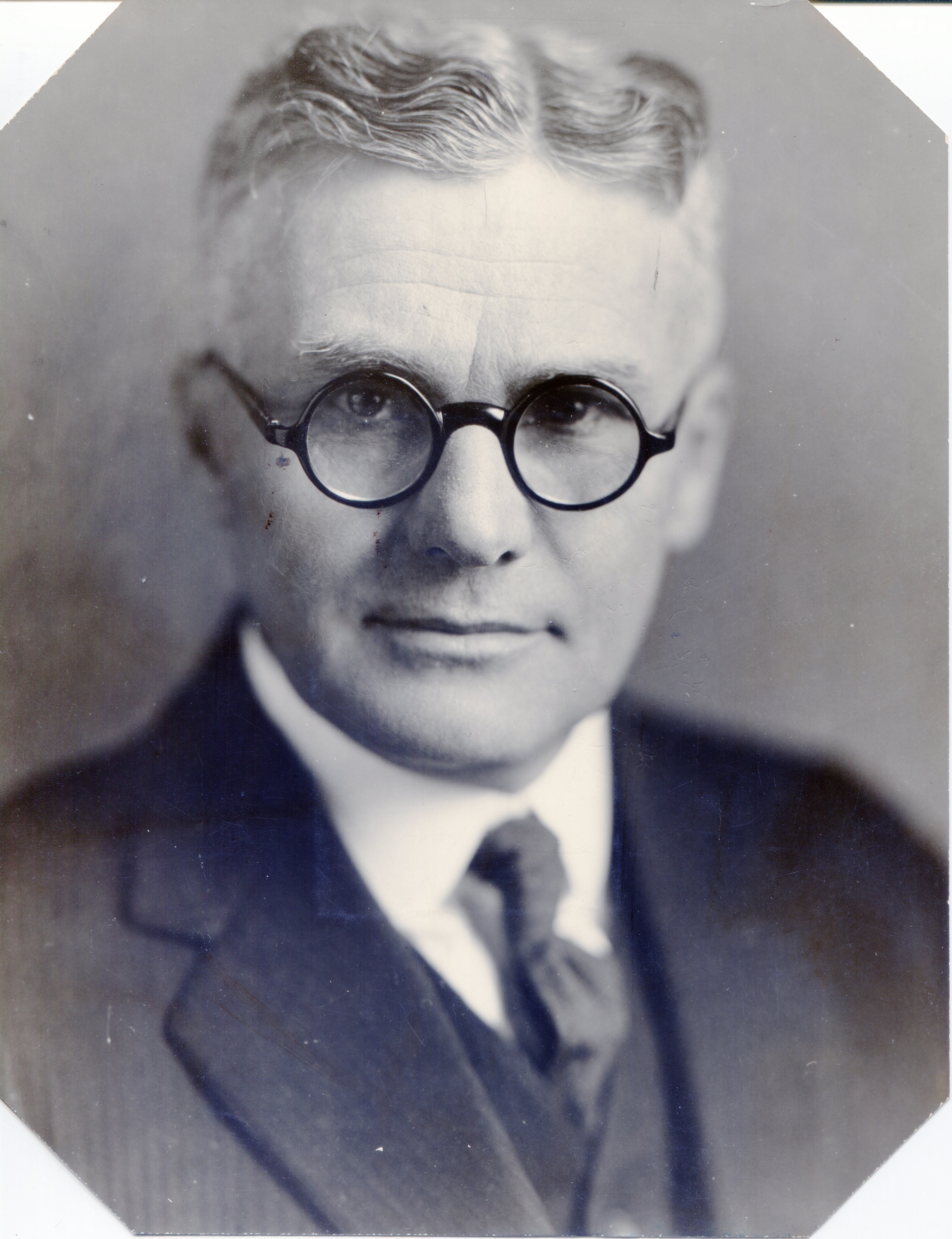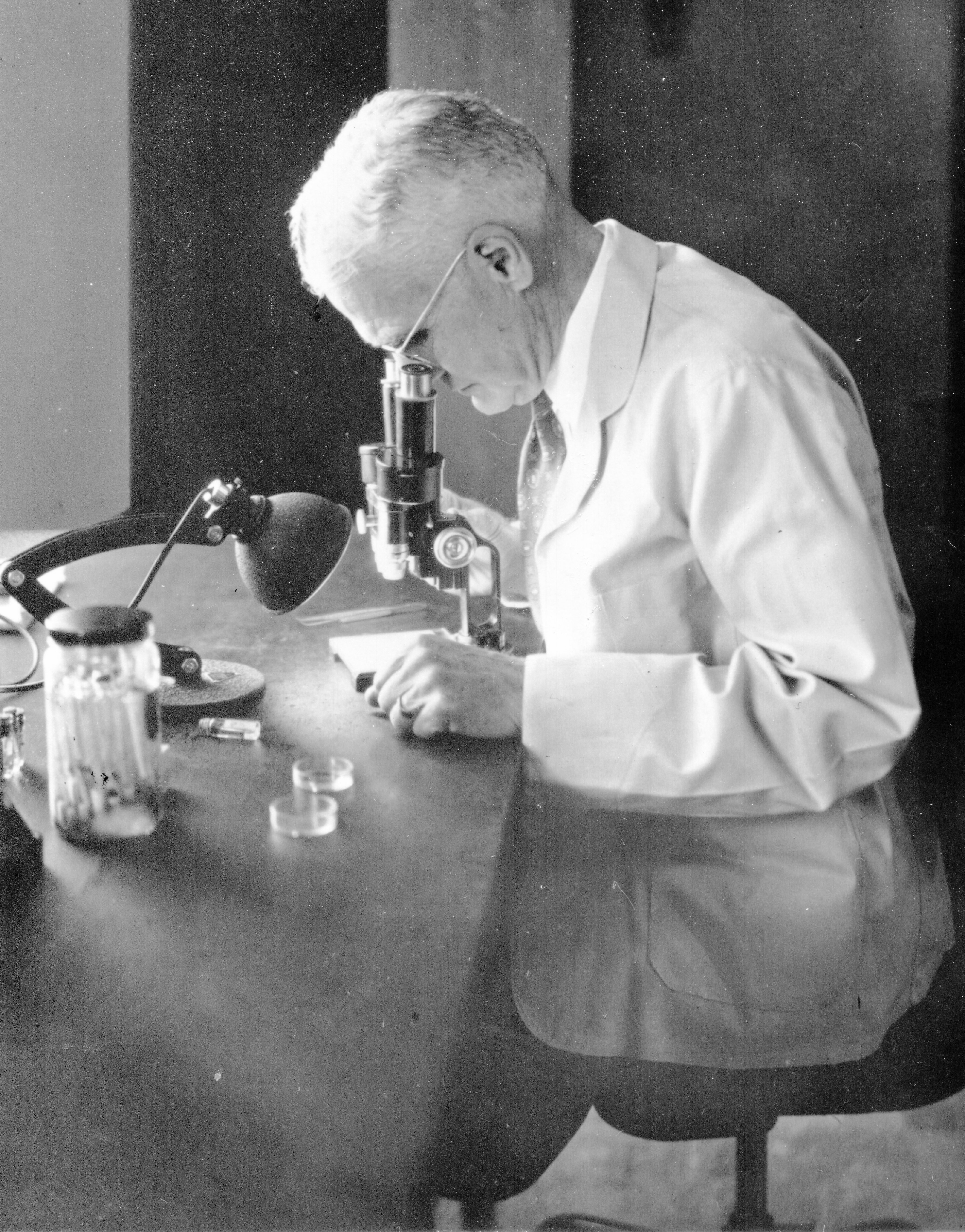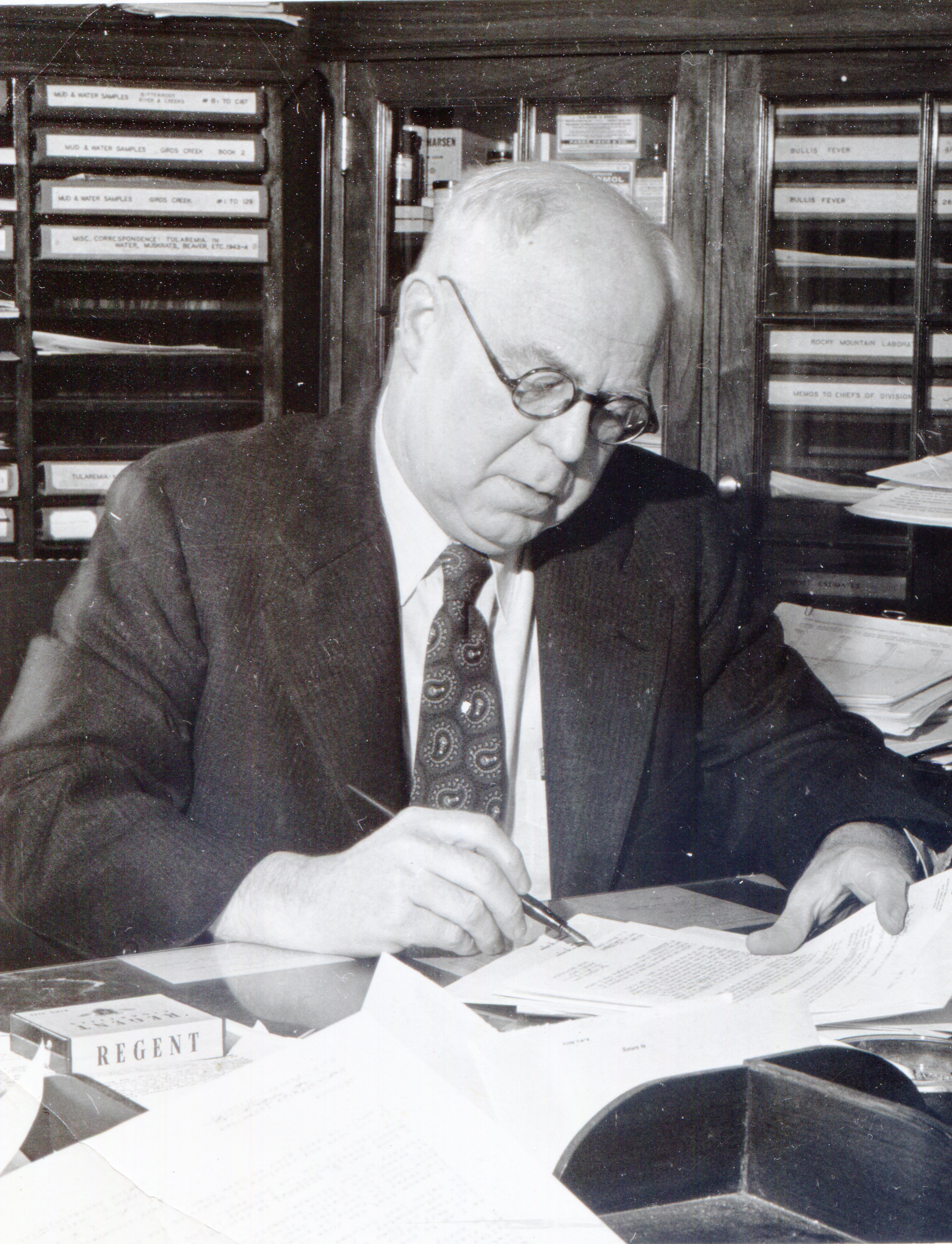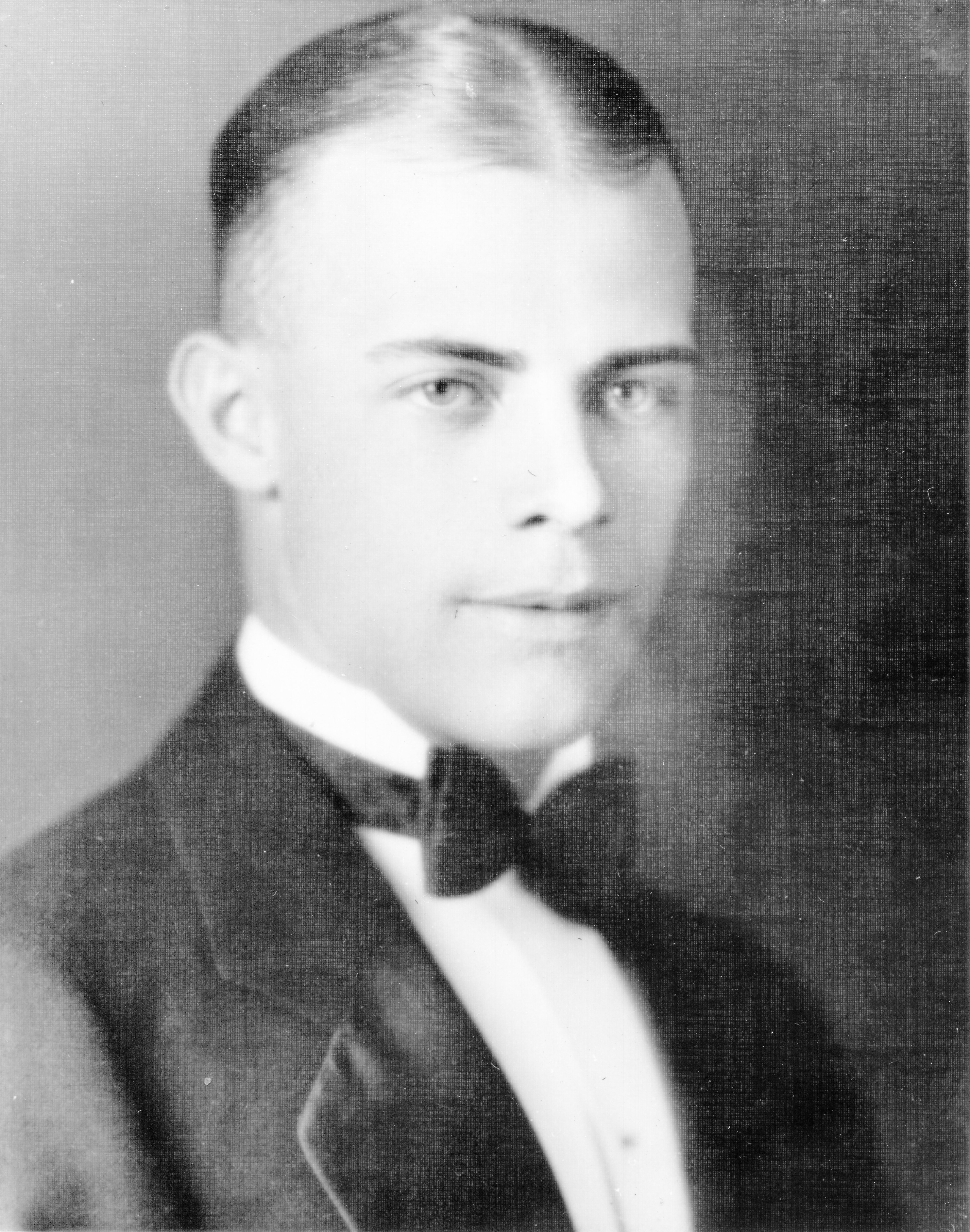Canyon Creek Schoolhouse Laboratory People
Along with many other men and women, these people worked at the Canyon Creek Schoolhouse laboratory during the years 1921–1928 and played important roles in the research on Rocky Mountain spotted fever (RMSF). Three of them lost their lives researching RMSF during the schoolhouse years.
Leaders’ Profiles
Robert Allen Cooley (1873 – 1968)
Dr. Robert Cooley was an energetic person. Over his 47-year career as an entomologist (a person who studies insects) in Montana, he taught students, dipped cows, created a world-class collection of ticks, and did basic research on Rocky Mountain spotted fever (RMSF).
Cooley was born in Deerfield, Massachusetts, and graduated from Massachusetts Agricultural College with a BS degree in 1895. Although he was only 26-years old, he became head of the Department of Zoology and Entomology at Montana State College. In 1903, he helped get legislation passed in Montana to establish the position of State Entomologist for Montana, and he became the first one to hold the position. It was his job to travel the state and study outbreaks of insects injurious to crops or people. He began with a $300 travel budget, which would be a little over $9,000 today. On an assignment to the Bitterroot Valley during July 8–24, 1903, Cooley investigated outbreaks of oyster-shell bark-louse on apple trees and the apple tree borer. He submitted an expense sheet for $21.85.
But his work shifted from insects wreaking agricultural havoc to insects causing human illness, especially RMSF, which is transmitted by tick bites. He thought that humans might be coming into contact with the ticks through their livestock and in the 1910s recommended that livestock such as cattle be “dipped” in disinfectant to control ticks. He conducted an exhaustive study of the life cycle of the Rocky Mountain wood tick, or Dermacentor andersoni, which was a carrier of RMSF. In the process, he collected many species of ticks, creating an unrivalled research collection.
He was in charge of Montana’s RMSF work between 1917–1921, which were years when the U.S. Public Health Service was not involved in this work. When the Public Health Service and the State of Montana began working together again on RMSF, at Montana’s request, at the Canyon Creek Schoolhouse laboratory, Cooley was there as head entomologist. In 1931, he became a Public Health Service employee instead of a Montana state employee, and also retired from his position at Montana State University. In 1936, he received an honorary doctorate from Montana State College, receiving the “Dr.” title that he had earned several times during his career. He stayed at Rocky Mountain Laboratory (it became plural in 1982) until he retired in 1946.
Robert A. Cooley died in 1968 at the age of 95 in Hamilton, Montana, in the Bitterroot Valley which had been one of his first research trips as a young entomologist in 1903. The Cooley Laboratory at Montana State University, dedicated to biomedical research, is named in his honor.
Learn more about Cooley:
“The namesake for the newly renovated Cooley Laboratory helped lead the fight against Rocky Mountain spotted fever,” by Sepp Jannotta, MSU News, Oct. 12, 2012.
“Robert Allen Cooley, 1973-1968,” Glen M. Kohls, Journal of Economic Entomology, Volume 62, Issue 4, 1 August 1969, Page 972.
Dr. Robert A. Cooley Image: Office of NIH History and Stetten Museum, 1571-1
Dr. Robert A. Cooley looked at a vial of ticks while sitting in front of a dissecting microscope. This photo was most likely taken in the 1940s at the Rocky Mountain Laboratory's Building One. Image: Office of NIH History and Stetten Museum, 1580-2
Ralph Robinson Parker (1888 – 1949)
While the story of the defeat of Rocky Mountain spotted fever (RMSF) would not be complete without Dr. Ralph R. Parker, Parker’s story encompasses many more diseases and research accomplishments. Parker was born in Malden, Massachusetts, and went to the Massachusetts Agriculture College. In 1914, Robert Cooley, who was the State Entomologist of Montana but who had also been born in Massachusetts and gone to Massachusetts Agricultural College, invited Parker to come to Montana to study flies and the transmission of typhoid fever. The next summer, Cooley invited Parker to Montana again, this time to study RMSF. Parker did this work on the Powder River in eastern Montana.
Montana must have fascinated Parker. After receiving his Ph.D. in 1915 and getting married, he and his new wife moved to Montana, living in the same log cabin where he did work for the Montana State Entomological Board. He hunted game so that he and his wife could collect ticks from them for his research. Their living and working conditions were upgraded just a little in 1918 when they moved to the Bitterroot valley to work in a woodshed in the town of Victor. It was known that ticks transmitted RMSF through their bites, so Parker looked for a way prevent transmission by controlling ticks as well as doing more in-depth studies into the transmission of the disease.
In 1921, the incidence of the often-fatal RMSF in the Bitterroot valley was rising, so Montana asked the U.S. Public Health Service to resume working with them on the problem. The laboratory was moved from the woodsheds in Victor to much more spacious and substantial quarters in the empty Canyon Creek Schoolhouse near Hamilton in September 1921. And Parker and his wife bought a real house and ten acres of land for their home the next month.
Dr. Ralph Parker reads correspondence at his desk at the Rocky Mountain Laboratory, circa 1948. Notice the labeled binders on his desk and in the bookcases behind him which indicate just a few of his research interests: tularemia, bullis fever, mud and water sampling, drugs (for treatment). In addition are examples of his role as first director of the Rocky Mountain Laboratories in binders containing monthly reports and construction project documents. On Parker’s desk is an assortment of reports and correspondence and even a box or two of reagents waiting to go on the shelf behind him. Image: Office of NIH History and Stetten Museum, 1466-3
The relationship between Parker, who worked for the State of Montana, and Dr. Roscoe Spencer, who was the Public Health Service officer in charge of the laboratory, was an arrangement that worked despite its awkwardness. Spencer developed the vaccine in the Hygienic Laboratory (precursor to the National Institutes of Health) in Washington, D.C., but more tests and then production of the vaccine occurred in the Canyon Creek Schoolhouse laboratory, which was run by Parker when Spencer wasn’t there. It was the production of the vaccine that led to the construction of a building especially designed for scientific work, which replaced the schoolhouse in 1928 and remains in use today.
Parker and Spencer collaborated on studies of other diseases as well. Tularemia and its transmission were another of Parker’s passions, whether it was transmitted by ticks, deer flies, or the pathogen Pasteurella tularensis which he found in ground water. He also studied Q fever, a bacterial infection that can cause heart valve problems, and which is often transmitted by breathing in contaminated air around infected animals such as livestock. Plague was first reported in Montana under Parker.
In 1930, the whole operation became part of the U.S. Public Health Service, and Parker became director of the Rocky Mountain Laboratory (it became plural in 1982). Choosing the right people for the job was one of Parker’s talents as an administrator. He convinced Dr. Herald Cox to join the laboratory to try to make producing the vaccine easier than requiring many stages of tick feedings. Cox lived up to Parker’s expectations by developing a way to grow the pathogen in chick embryos instead. This method is still used in the preparation of many vaccines. Dr. Mason Hargett was also enticed to the laboratory by Parker just before World War II. Yellow fever could have become a terrible problem for U.S. troops during the war, but Hargett and the Rocky Mountain Laboratory produced a vaccine that erased that national security concern.
When Parker died unexpectedly in 1949, he left behind contributions in many areas of tick and other insect transmitted diseases. For example, in 1937, he discovered a rickettsia (a group of small bacteria that cause various diseases in people and are transmitted through insect bites) isolated from the Gulf Coast tick, Amblyomma maculatum. This bacterium, which is also a cause of a spotted fever, was characterized as a unique Rickettsial species in 1965 and named Rickettsia parkeri in honor of its discoverer. That’s a fitting tribute for a person who increased our knowledge about insect-borne diseases so much.
“Ralph R. Parker,” Victor Haas, Science Magazine, Vol 111, January 20, 1950, page 56-57.
Roscoe Roy Spencer (1888-1982)
In many ways, Dr. Roscoe R. Spencer’s career in the Public Health Service spanned two distinct periods in the Service: in the earlier period, most officers deployed several times across the U.S. to investigate outbreaks of known and unknown causes; and in the later period, they often stayed at the National Institutes of Health for most of their career. Spencer’s involvement in creating a vaccine for Rocky Mountain spotted fever (RMSF) shares elements of both of these periods.
Unlike Robert Cooley and Ralph Parker, with whom he would work on RMSF, Spencer was a physician, not an entomologist. Born in West Point, Virginia, Spencer joined the Public Health Service after getting his A.B. degree from Richmond University in 1909 and his M.D. degree from Johns Hopkins University in 1913. Then his life as a Public Health officer moving from assignment to assignment began. He was in Victor, Montana, in 1915 (just before Parker) working on programs to control ticks, hoping that would limit spread of RMSF. During World War I, he was detailed to the U.S. Navy as a Sanitary Advisor—proper sanitation was the only way to prevent many diseases at the time. In that role, he went to Pensacola, Florida, to head up bubonic plague control efforts. After the war ended, he spent three years in New Orleans, Louisiana, also leading plague-suppression efforts.
Dr. Roscoe Roy Spencer in his U.S. Public Health Service uniform. Image: Office of NIH History and Stetten Museum, 1576
His best-known work began in 1922, when he was assigned to work with Parker, an entomologist employed by the State of Montana. They were to investigate an RMSF outbreak in the Bitterroot Valley. They knew that RMSF was spread by tick bites but had not been able to culture the microorganism carried by the ticks, so they investigated infected ticks as a potential source of an antigen for a vaccine.
Spencer developed the RMSF vaccine in Washington, D.C., not in the Canyon Creek Schoolhouse laboratory. On May 24, 1924, Spencer became the first human exposed to the new vaccine when he inoculated himself. He then went back to Montana to complete more trials of the vaccine with Parker and to set up vaccine production, traveling back and forth many times. In 1930, the American Medical Association awarded Spencer its gold medal for this work.
Then came the beginning of Spencer’s more modern experience as a Public Health Service officer. After leaving the Canyon Creek Schoolhouse laboratory to return to Washington, D.C., in 1928, Spencer continued his medical bacteriology research at the Hygienic Laboratory, which became the National Institutes of Health in 1930. In 1937, President Franklin Roosevelt signed the act creating the National Cancer Institute. Dr. Carl Voegtlin became director of the new institute and appointed Spencer his assistant director; Voegtlin was neither a physician nor a career Public Health Service officer. Spencer, who had no training in cancer research, accepted the assignment and requested a laboratory to conduct research.
Spencer became director of the National Cancer Institute in 1943, when Voegtlin retired, but stepped down himself in 1947, having served during the difficult years of World War II. Spencer was the consummate Public Health Service officer, not an administrator; he left just in time to miss the next era of the Public Health Service: the era of Big Science.
Dr. Roscoe Roy Spencer poses at his desk, May 10, 1928. Note the candlestick-style telephone connected to a large telephone box. Spencer came across as unassuming and pleasant but, as evidenced by his socks, he was secretly bold, giving the first dose of Rocky Mountain spotted fever vaccine to himself to test its safety and efficacy in humans.
Image: Office of NIH History and Stetten Museum, 1576 and 1577"Historical Note: Roscoe Roy Spencer (1888–1982)," Michael Shimkin, Journal of the National Cancer Institute, Vol. 72, No. 5, May 1984, pp. 969-971.
In Memoriam
“What shall we say of the some twenty-five workers, who fully appreciating the dangers incident to the daily routine, still continue at a rate of compensation not higher than the gain in other kinds of work in which these dangers are lacking. We may say, at least, that idealism and the spirit of sacrifice for the general good have not died out.”
- (Quote: “The Cooperation with the United States Public Health Service,” Robert A. Cooley, Eighth Biennial Report, Montana State Board of Entomology, 1929–1930, page 10.)
The 25 workers who Cooley wrote about included people working for both the State of Montana and the U.S. Public Health Service. Three of these researchers died during the years that the Rocky Mountain spotted fever (RMSF) work was being done at the Canyon Creek Schoolhouse laboratory. Cooley had taught two of them—William Gittinger and Arthur Kerlee—at Montana State College. On June 6, 1929, Cooley dedicated the Gittinger-Kerlee memorial plaque at Montana State College to his former students.
William Edwin Gittinger (1899-June 30, 1922)
William Gittinger graduated from high school around 1918. He then attended the Montana State College, graduating from Dr. Robert Cooley’s entomology program. He hoped to go to medical school but took a job as a junior laboratory assistant in the Canyon Creek Schoolhouse laboratory. He had only worked there a short while when he was infected by Rocky Mountain spotted fever and died on June 30, 1922. He was almost 23 years old and left his mother, two sisters, and a brother. According to Lucy Salamanca, after Gittinger died, Dr. Roscoe Spencer posted a sign on the laboratory door: ‘‘Persons entering these premises do so at their own risk!”
Image: Office of NIH History and Stetten Museum, 3521
George Henry Cowan (January 8, 1886- Oct. 29, 1924)
George Cowan was born in Victor, Montana. His parents were among the original White settlers of the area. A field station for studying Rocky Mountain spotted fever (RMSF) was located in Victor before moving to the Canyon Creek Schoolhouse laboratory in Hamilton, Montana.
Cowan joined the RMSF investigation in 1913 and was the longest-serving field worker at the time of his death. The Montana State Board of Entomology made him deputy chief of tick control work in 1921, and he continued that work with the U.S. Public Health Service in the Canyon Creek Schoolhouse laboratory. Cowan helped to collect ticks and when he shot a certain mountain goat, more than a thousand already engorged ticks were picked off of it. Dr. Roscoe Spencer tested to see if the ticks caused RMSF, discovered that ticks had to be fed before they became infectious, and got the idea to grind the ticks into an RMSF vaccine. Unfortunately, the vaccine was not completed before Cowan became ill with RMSF and died in October 1924.
Image: Office of NIH History and Stetten Museum, 1575
Arthur LeRoy Kerlee (March 5, 1905-February 14, 1928)
Arthur Kerlee was born and educated in Darby, Montana—a local boy studying Rocky Mountain spotted fever (RMSF) at the Canyon Creek Schoolhouse laboratory. He graduated from Montana State College in 1927 with a B.S. in Botany and Bacteriology. Robert Cooley was one of his professors. After graduating, Kerlee became an assistant bacteriologist in the U.S. Public Health Service at the Canyon Creek Schoolhouse laboratory. He co-authored a paper with Dr. Roscoe Spencer on the Weil-Felix reaction as a diagnostic test for RMSF.
Kerlee died during production of the RMSF vaccine. Because he had already received the vaccine, his death caused some consternation in the Bitterroot Valley until it was found that he had only received the first shot and had become ill either right before the shot or right after the shot, meaning that his immunity had not had a chance to develop.
Image: Office of NIH History and Stetten Museum, 1578
A large number of Bitterroot Valley citizens attended his funeral, which included a quartet and a military tribute from the American Legion because he had been made a 2nd lieutenant in the reserve officer’s training corps. He left a father, four brothers, and two sisters. One of his brothers, James, joined the Canyon Creek Schoolhouse laboratory in tribute to his sacrifice.









